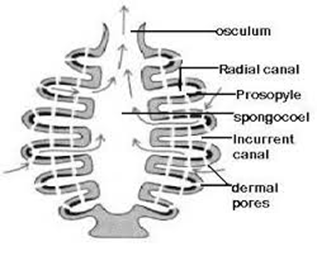Obelia Life Cycle, classification , Labelled Diagram
Obelia Life Cycle
Obelia is named after a Greek word, "obelus," which means "a loaf on a spit." These are marine creatures that live in shallow coastal waters. They attach to the ocean floor, growing upward like a furry plant, which is why they're sometimes called "Sea fur" or "hydrozoites."
Obelia goes through three important life phases: polyp, blastostyles, and medusa
🔬 Classification of Obelia:
- Kingdom - Animalia
- Phylum - Cnidaria
- Class - Hydrozoa
- Order - Leptothecata
- Family - Campunulariidae
- Genus - Obelia
General Feature -
- Obelia is generally marine and colonial animals.
- They are cosmopolitan in nature.
- They have tissue but lacks the organ systems. Thus, they have a tissue level of organization.
- They show radial symmetry.
- They are diploblastic in nature, the outer wall is called ectodermis and the inner one is called gastrodermis. Between this tow layer a sheet of gelatinous material is found called mesoglea.
- They have a single aperture, the mouth which serves both the purpose of taking food and throwing the feces. Their digestive cavity is incomplete.
- Digestion is partially extracellular and partly intracellular takes place within the gastrodermal cells.
- The body shows two forms, polyp, and medusa. The polyp is cylindrical and usually fixed but may be solitary or colonial. The medusa is umbrella-like in appearance and is free-swimming, but always solitary.
- Polyps are nutritive in function.
- It is a plant-like appearance and is therefore called zoophytes. There present two types of zooids.
- The horizontal filament is known as hydrorhiza.
- The vertical filament is called hydrocauli.
- They reproduce by both types of reproduction - asexually & sexually.
- There is the absence of the brain in Obelia.
- They are colonial in nature.
- They are holozoic.
- No circulatory system found in Obelia.
- Fertilization is of both types - internal and external.
- They respire by diffusion.
- They have tissue level of organization.
Life Cycle of Obelia - Generally, Obelia reproduces by both means; sexually as well as asexually either through polyp or through medusa.
Polyp - Polyp are the soft-bodied sedentary form of phylum Cnidaria. The upper body of polyp is surrounded by the tentacles and from the lower body, it is attached to the solid surface . It is a type of body form in phylum Cnidaria. In phylum Cnidaria, the polyp present in either colony or individual. In Obelia, there are two types of a polyp ( Dimorphic) - Gastrozooids and another one is gonozooids.
Gastrozooids are just like flowers having tentacles surrounding a mouth helps to gather the food to eat . These Gastrozooids are connected through a cavity known as Gastrovascular cavity. Gonozooids are also called as blastozooids are cylindrical rod-like reproductive bodies present on the stalk of gastrozooids. The significant function of the gonozooids is to produce numerous small medusae. This small medusa detached after attaining maturity and moves into the surrounding water through gonopore.
"Question - how does the medusa stage fit into the life cycle of obelia?"
Medusa - Gonozooids produce Medusa through asexual division. Medusa produced are extremely similar to the appearance of jellyfish having tentacles outside. Medusa is free- swimming, small, saucer-shaped zooids. They will mature and detached from their parent and dispersed into the ocean. Medusa has two sides - outer convex - ex umbrella & inner concave - sub umbrella. A small projection, the manubrium, is hanging down from the sub umbrella region giving medusa an umbrella-like shape. When the food enters the mouth it reaches the manubrium and then distributed to the canal, the radial canal, and outer ring. They have also known as reproductive zooids, producing male or female sex cells.
Sexual reproducing Cycle - The medusa of male and female gonads are fuse to form a zygote. This zygote later change into blastula by cell division. This blastula further grows to from Larva called Planula.
Now, this planula attaches to the solid substratum and starts diving asexually producing Polyp. These poly grows and forms some gastrozooids and some gonozooids. Gonozooids eventually form more medusae that will be released to mate and complete their life cycle.




Comments
Post a Comment